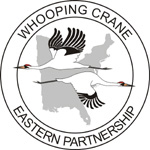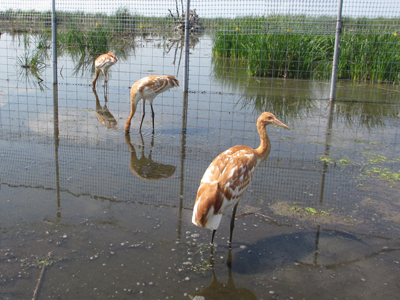 |
| Share this video with your friends and help us spread the word that disturbing, harassing or killing Whooping Cranes is a crime. |
 Report a Whooping Crane sighting Report a Whooping Crane sighting |
 Make a gift to support Whooping Crane conservation. Make a gift to support Whooping Crane conservation. |
Media Contact: Joan Garland, ICF Outreach Coordinator, 608-381-1262
View our photo album of the Whooping Crane chicks’ transfer to Horicon NWR
Six Whooping Crane chicks arrived last week at Horicon National Wildlife Refuge (NWR) in Dodge County, Wis. The cranes are part of the Direct Autumn Release (DAR) project conducted by the Whooping Crane Eastern Partnership (WCEP), an international coalition of public and private organizations that is reintroducing this highly imperiled species in eastern North America, part of its historic range.

The Whooping Crane chicks, ranging in age from 12-15 weeks old, spent six weeks at Necedah NWR in Juneau County, Wis., getting acclimated to wetland habitats and wild cranes, before arriving at Horicon NWR. While the birds are housed on the refuges, they remain under the watchful eye and supervision of costumed biologists from WCEP project partner, International Crane Foundation. In mid-late October the cranes will be released on Horicon NWR in the company of older cranes. The young DAR whooping cranes learn the migration route south by following these older birds.
“The staff at Horicon NWR is excited about the arrival of this year’s DAR chicks and is glad to be working with such great partners on this reintroduction project,” said Steve Lenz, Project Leader for the Horicon NWR/Leopold Wetland Management District Complex.
In addition to the six DAR birds, six Whooping Crane chicks are currently being conditioned to follow ultralight aircraft by WCEP partner Operation Migration at the White River Marsh State Wildlife Area in Green Lake and Marquette Counties, Wis.
Thanks to the efforts of WCEP, there are now 104 Whooping Cranes in the eastern migratory population. WCEP celebrated a milestone this summer with a record number of chicks hatched in the wild. Nine chicks hatched to eight pairs of cranes. Two of the chicks, #W1-12 and #W8-12, survived to fledging. In total, 24 Whooping Crane chicks have hatched in this population since 2006. Five of them, including #W1-12 and #W8-12, have fledged and joined the wild population.
Whooping Cranes were on the verge of extinction in the 1940s. Today, there are only about 600 birds in existence, approximately 445 of them in the wild. Aside from the 104 WCEP birds, the only other migratory population of Whooping Cranes nests at Wood Buffalo National Park in northern Alberta, Canada and winters at Aransas NWR on the Texas Gulf Coast. A non-migratory flock of approximately 20 birds lives year-round in the central Florida Kissimmee region, and an additional 17 non-migratory cranes live in southern Louisiana.
WCEP asks anyone who encounters a Whooping Crane in the wild to please give them the respect and distance they need. Do not approach birds on foot within 200 yards; remain in your vehicle; do not approach in a vehicle any closer than 100 yards. Also, please remain concealed and do not speak loudly enough that the birds can hear you. Finally, do not trespass on private property in an attempt to view or photograph Whooping Cranes.
Whooping Crane Eastern Partnership founding members are the International Crane Foundation, Operation Migration, Inc., Wisconsin Department of Natural Resources, U.S. Fish and Wildlife Service, the U.S. Geological Survey’s Patuxent Wildlife Research Center and National Wildlife Health Center, the National Fish and Wildlife Foundation, the Natural Resources Foundation of Wisconsin, and the International Whooping Crane Recovery Team.
Many other flyway states, provinces, private individuals and conservation groups have joined forces with and support WCEP by donating resources, funding and personnel. More than 60 percent of the project’s budget comes from private sources in the form of grants, public donations and corporate sponsors.
